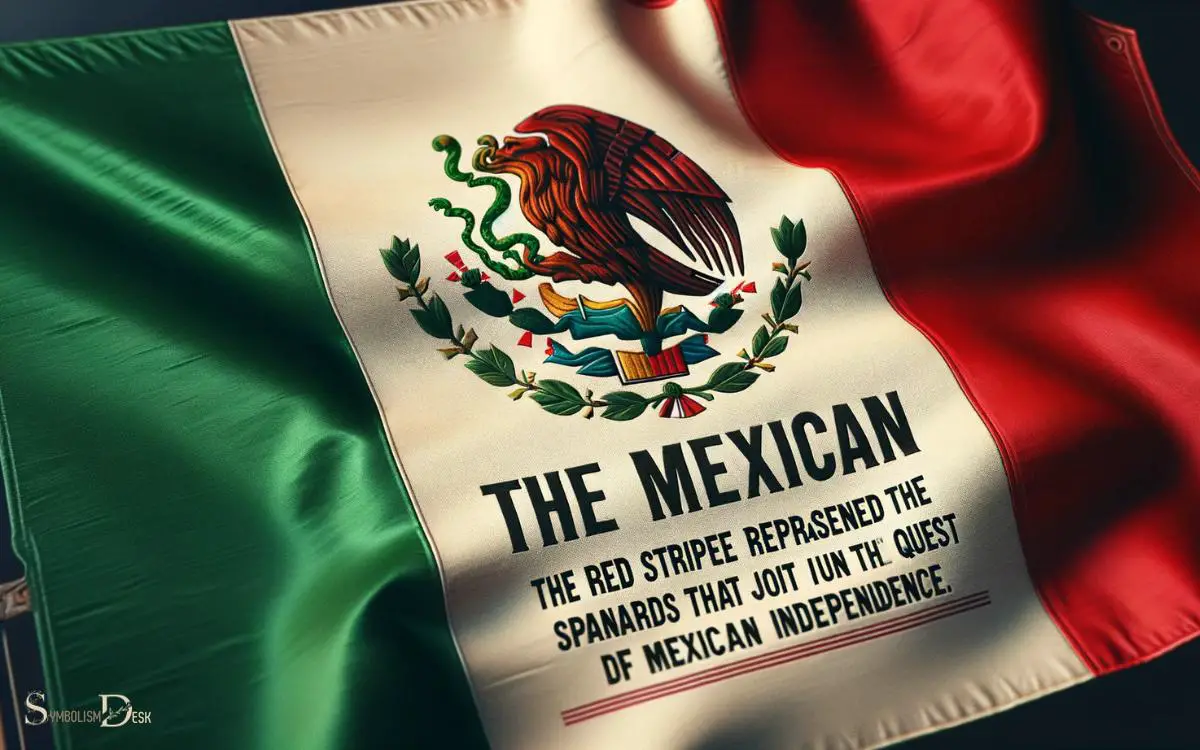What Do the Symbols on the Mexican Flag Mean? Culture!
The symbols on the Mexican flag represent the country’s rich history, culture, and the struggle for independence.
The flag consists of three vertical stripes in green, white, and red, with the national emblem in the white stripe, representing the Catholic faith, hope, and unity, respectively, and a symbol of the Aztec legend of the founding of Tenochtitlan.
The Mexican flag’s national emblem is an eagle perched on a prickly pear cactus, holding a snake in its beak and talons.
This image is based on an ancient Aztec legend, which states that the gods instructed the Aztec people to build their capital city where they found an eagle on a cactus devouring a snake.

Key Takeaway
8 Symbols on the Mexican Flag: A Detailed Table
| Symbol on Mexican Flag | Meaning |
|---|---|
| Green Stripe | Hope and the Independence movement |
| White Stripe | Purity of the Catholic faith |
| Red Stripe | The blood of those who fought for Mexico’s freedom |
| Coat of Arms (center) | National identity and heritage |
| Eagle | Represents Aztec heritage and strength |
| Serpent | Symbolizes the defeat of evil and foreign enemies |
| Cactus | Represents the founding of the Aztec city of Tenochtitlan |
| Oak and Laurel Branches | Represent victory and honor |
What do the Symbols on the Mexican Flag Mean
The Mexican flag, known as the “Bandera de México” in Spanish, features three vertical stripes of green, white, and red, with a coat of arms in the center.
Each of these elements carries specific symbolism:
Green Stripe: The green stripe on the left side of the flag represents hope and the independence movement of Mexico. It is often associated with the lush vegetation of the country and its agricultural richness.
White Stripe: The white stripe in the middle represents purity and unity. It is said to symbolize the Catholic faith of the Mexican people and their desire for peace.
Red Stripe: The red stripe on the right side represents the blood shed by those who fought for Mexico’s independence. It symbolizes the country’s struggle for freedom and independence from Spanish colonial rule.
Coat of Arms: The center of the flag features Mexico’s national coat of arms, which consists of an eagle perched on a cactus while devouring a snake. This image has historical significance and is derived from an Aztec legend.
According to legend, the god Huitzilopochtli told the Aztecs that they should establish their city, Tenochtitlan (now Mexico City), where they saw an eagle devouring a snake on a cactus.
The coat of arms symbolizes the founding of Mexico City and the fulfillment of a divine prophecy. It also represents the triumph of good (the eagle) over evil (the snake).
The History of the Mexican Flag
The history of the Mexican flag dates back to the early 19th century, reflecting the country’s struggle for independence and its evolving national identity.
The first national flag was created in 1821, following Mexico’s independence from Spain. It featured vertical tricolors of green, white, and red, with the national emblem in the center.
Over the years, the flag has undergone several modifications, with the current design being officially adopted in 1968. This rich history mirrors the country’s journey towards sovereignty and its cultural heritage.
Understanding the historical context of the Mexican flag provides insight into the symbolism and significance of its elements, particularly the iconic eagle.
The symbolism of the eagle embodies the essence of Mexico’s cultural and historical narrative, representing strength, resilience, and the nation’s indigenous roots.
The Symbolism of the Eagle
The eagle on the Mexican flag is a symbol of strength and resilience, representing the country’s enduring spirit.
Additionally, the eagle is deeply tied to Mexico’s Aztec heritage, serving as a powerful reminder of the nation’s rich history and cultural roots.
These two aspects of the eagle’s symbolism contribute to the flag’s representation of Mexico’s strength and pride.
Eagle Represents Strength
Representing strength and power, the eagle on the Mexican flag holds significant symbolism.
The eagle embodies several meanings that resonate with the Mexican people:
- Strength and Leadership: The eagle represents the strength and leadership of the Mexican nation.
- Courage and Tenacity: It symbolizes the courage and tenacity of the Mexican people in the face of adversity.
- Freedom and Independence: The eagle reflects the country’s hard-fought freedom and independence.
- Connection to Nature: It signifies the deep connection between the Mexican people and the natural world.
- Majesty and Pride: The eagle’s majestic presence on the flag instills a sense of pride and honor in the country’s heritage.
The symbolism of the eagle on the Mexican flag goes beyond mere representation, delving into the rich history and cultural significance of the nation. This is further emphasized by the eagle’s representation of Aztec heritage.
Eagle Signifies Aztec Heritage
Symbolizing the rich Aztec heritage, the eagle on the Mexican flag is laden with historical and cultural significance, further amplifying its representation of strength and power.
The eagle holds a special place in Aztec mythology, where it was considered a symbol of power, courage, and the sun.
According to legend, the Aztecs were instructed by their god, Huitzilopochtli, to settle in a place where they observed an eagle perched on a cactus, devouring a snake. This mythical sighting led them to found their capital city, Tenochtitlan, where modern-day Mexico City now stands.
The eagle’s presence on the flag honors this origin story and serves as a powerful reminder of Mexico’s indigenous roots. Its position atop a cactus devouring a snake also symbolizes the triumph of good over evil.
The Meaning of the Cactus
The cactus on the Mexican flag holds deep significance, symbolizing the resilience of the Mexican people in the face of adversity. This enduring plant represents the ability to thrive in harsh conditions and reflects the strength and determination of the nation.
Furthermore, the cactus is a powerful emblem of Mexican identity, embodying the spirit of perseverance and pride in the face of challenges.
Cactus as Resilience Symbol
The cactus on the Mexican flag represents resilience and strength in the face of adversity. The choice of the cactus as a national symbol holds deep significance, reflecting the tenacity and adaptability of the Mexican people.
The cactus serves as a powerful metaphor for overcoming challenges and thriving in harsh conditions, embodying the following qualities:
- Endurance in arid environments
- Ability to withstand extreme temperatures
- Capacity to flourish in difficult terrain
- Symbol of protection and resilience
- Representation of survival and sustainability
The cactus’s portrayal on the Mexican flag encapsulates the nation’s spirit of perseverance and unwavering determination in the face of obstacles. This enduring emblem reflects the essence of Mexican identity and the indomitable spirit of its people.
Cactus and Mexican Identity
A prominent symbol on the Mexican flag, the cactus embodies the resilience and strength inherent in Mexican identity.
The cactus is a representation of the ability to thrive in harsh conditions and adapt to the environment, reflecting the Mexican people’s tenacity and perseverance. Its presence on the flag signifies the unity and determination of the nation to overcome challenges.
The cactus also holds cultural significance, as it has been used in Mexican folklore and traditional medicine for centuries. Below is a table that outlines the symbolic meanings associated with the cactus in Mexican culture:
| Symbolic Meaning | Description |
|---|---|
| Resilience | Ability to withstand adversity and thrive |
| Adaptability | Capacity to adjust to challenging circumstances |
| Strength | Representation of fortitude and endurance |
| Endurance | Ability to persist and endure over time |
| Unity | Signifies the solidarity and cohesion of Mexico |
The cactus, with its rich symbolism, serves as a powerful emblem of Mexican identity, reflecting the nation’s history and spirit. This identity is further exemplified through the colors of the Mexican flag, as discussed in the subsequent section.
Significance of the Green, White, and Red Colors
Signifying different aspects of Mexico’s heritage and values, the green, white, and red colors on the Mexican flag hold deep historical significance.
- Green: Represents hope and the independence movement.
- White: Symbolizes unity and the Catholic faith of the Mexican people.
- Red: Stands for the blood of the national heroes who fought for Mexico’s independence.
- Vertical Orientation: The green is on the left side, symbolizing the nation’s independence and the lush landscape. The white is in the middle, signifying the purity of the Catholic faith. The red is on the right, representing the blood of the national heroes.
The colors on the Mexican flag are not just a matter of aesthetics but are deeply rooted in the country’s history, culture, and values, serving as a powerful symbol of Mexican identity and pride.
Evolution of the Mexican Flag Design
In the evolution of the Mexican flag design, the changes and modifications reflect the country’s historical and political developments.
The original design, adopted in 1821, featured a vertical tricolor of green, white, and red. Over time, the coat of arms in the center underwent several alterations, representing different aspects of Mexico’s history and identity.
In 1968, the government officially adopted the current version of the national flag, incorporating the emblem of an eagle devouring a snake while perched on a prickly pear cactus. This emblem holds significant cultural and historical symbolism for the Mexican people.
The evolution of the flag’s design mirrors the nation’s journey, from its pre-Columbian roots to its colonial history and eventual independence.
This emblematic evolution underscores the deep-rooted significance of the Mexican flag to its people, shaping their cultural impact and national pride.
What Does the Symbol on the Bolivian Flag Represent in terms of Culture?
The symbol on the Bolivian flag, known for its symbol on bolivian flag meaning in culture, represents the country’s deep-rooted indigenous heritage. The centerpiece features a golden coat of arms with an Andean condor, llamas, and a lush palm tree. These elements symbolize Bolivia’s natural beauty, abundance, and its respect for native wildlife, reflecting the significance of culture and connection to the land.
Are the Symbols on the Mexican Flag Related to the Symbols on the Spain Flag?
The symbols on the Mexican flag are not directly related to the symbols on the Spain flag. While the Mexico flag features an eagle standing on a cactus and devouring a serpent, the Spain flag symbolizes national unity through its red-yellow-red horizontal triband design.
Cultural Impact and National Pride
One must appreciate the profound cultural impact and national pride that the Mexican flag symbolizes. The flag serves as a unifying symbol for the people of Mexico, representing their rich history, traditions, and values.
Its significance goes beyond being a mere piece of cloth, evoking strong emotions and a sense of belonging among Mexicans.
Here are five ways the Mexican flag holds cultural significance and inspires national pride:
- Historical Legacy: The flag’s design reflects the Aztec legend of the founding of Tenochtitlan, now Mexico City.
- Unity and Identity: It unites the diverse Mexican population under one common emblem, fostering a sense of national identity.
- Patriotic Celebrations: The flag is prominently displayed during national holidays and celebrations, reinforcing patriotic sentiments.
- Symbol of Resistance: It has been used as a symbol of resistance and resilience throughout Mexico’s history.
- Global Recognition: The flag is a recognized symbol of Mexico worldwide, representing its cultural heritage and national pride.
Conclusion
In conclusion, the symbols on the Mexican flag hold deep historical and cultural significance for the Mexican people. These symbols represent the legacy of the Aztec and other indigenous civilizations, as well as the impact of Spanish colonization. The eagle, serpent, and cactus symbolize the ancient legend of the founding of Tenochtitlan, while the green, white, and red colors echo the traditional colors of Mexico. When comparing the Mexico flag to the Spain flag symbol meaning, it’s clear that the Mexican flag includes elements of both indigenous and colonial history, serving as a powerful emblem of the country’s complex and layered identity.
The eagle, cactus, and colors of green, white, and red all represent important aspects of Mexico’s heritage and national identity.
The evolution of the flag’s design reflects the country’s changing values and beliefs.
As a result, the Mexican flag continues to be a source of national pride and unity, representing the strength and resilience of the Mexican people.






